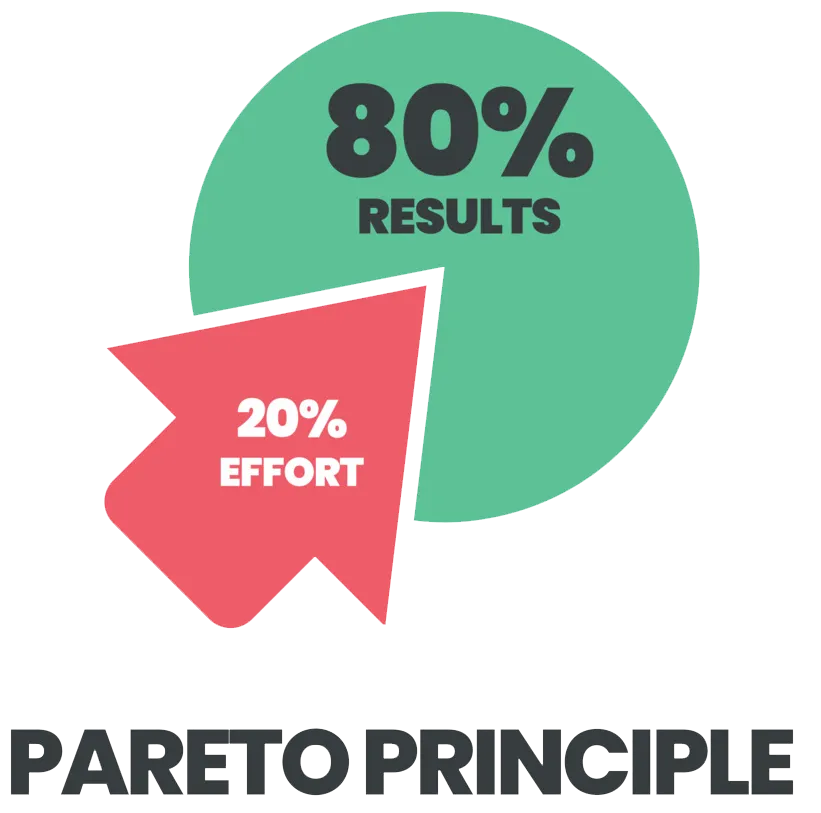
Harnessing the Pareto Principle: How to Select the Optimal Mix of Marketing Channels
"It's not always that we need to do more but rather that we need to focus on less."
- Nathan W. Morris.”
Introduction
In an era saturated with diverse marketing channels, choosing the right mix can feel like trying to boil the ocean. The key to successfully navigating this landscape lies in the Pareto Principle, a powerful tool for prioritizing efforts and resources. In this article, we explore how to apply the Pareto Principle to marketing channel selection and the crucial role of ROI in this decision-making process.
The Pareto Principle: A Beacon for Marketing Channel Selection
The Pareto Principle, often referred to as the 80/20 rule, postulates that 80% of outcomes result from 20% of causes. In marketing, this may translate to 80% of your revenue being generated by 20% of your marketing channels. Identifying and focusing on these high-performing channels allows for a more efficient use of resources, enabling marketers to generate substantial results without spreading themselves too thin.
Navigating the Marketing Channels: ROI as Your Compass
Return on Investment (ROI) stands as a critical metric in identifying the 20% of marketing channels that yield 80% of results. ROI measures the profitability of investments and, in this context, indicates which marketing channels are providing the best return. By consistently evaluating the ROI of different marketing channels, marketers can identify the most lucrative channels and prioritize them accordingly.
For example, if your email marketing campaigns consistently generate a high ROI, it would be beneficial to allocate more resources towards enhancing these campaigns rather than investing heavily in lower-performing channels.
Avoid Boiling the Ocean: The Power of Prioritization
In the vast sea of marketing channels, it can be tempting to try and tap into every possible avenue. However, this approach often leads to diluted efforts and suboptimal results. Instead, using the Pareto Principle to guide your channel selection allows for targeted, impactful marketing efforts.
Once the top-performing channels have been identified via ROI analysis, efforts should be concentrated on optimizing these channels. This might involve enhancing content, refining audience targeting, or expanding campaign reach within these select channels. By focusing on these fruitful avenues, you avoid boiling the ocean and instead, effectively steer your resources towards maximum impact and returns.
Conclusion
Applying the Pareto Principle in choosing marketing channels can provide a streamlined, results-oriented approach to digital marketing. Coupled with ROI-based decision making, this principle helps marketers identify and focus on the channels that truly matter, maximizing results without stretching resources thin. So, rather than attempting to boil the ocean, let the Pareto Principle guide you in making strategic, ROI-focused decisions that drive substantial returns on your marketing investments.
Why We're Obsessed with Metrics
"Half my advertising spend is wasted; the trouble is, I don’t know which half." - John Wannamaker
This quote is always on our team's mind. Most of us have an idea for what seems to be working and what doesn't, but unless we take the effort to truly deep dive into the numbers, we don't know for sure. That's where we come in.

We Cover the Full Spectrum of Digital Marketing
Starting with a Free Audit, we can quickly explain which tactics we think you need to focus on first. Or you can definitely create your own plan from the options below.

Digital Strategy
Before expending time and resources to tactics, we carefully evaluate the optimal digital strategy, using competitive analysis, historical data and recent trends in the industry.

PPC Advertising
It's important to have a healthy budget for spend. But it's also as important to evaluate the ROI for each dollar, ensuring that you are receiving a healthy return on your efforts.

Email Marketing
The highest ROI marketing channel has long been email marketing, with an estimated $40 in return for every $1 spent. If you haven't seen this year, we'll help you get there.

Marketing Automation
You can drive as much traffic as you can afford to your site, but unless you have a lead engine that can convert traffic to engaged leads, you will not see a difference in marketing performance.

CRM Administration
Marketing and sales need to be synced in their processes. Too often marketing leads do not qualify to sales leads--and the communication disconnect between the two teams is real. We can show you how to solve that.

Reporting and Analytics
Dashboards need to be precise, concise and include all the relevant team's input. A single source of truth is important to keep synergy between different teams. We take this a step further by adding expert insights to the numbers.
Office:
Orange County, CA
Call:
(714) 576-7187
Email: email@themarketingbranch.com
Site: www.themarketingbranch.com
